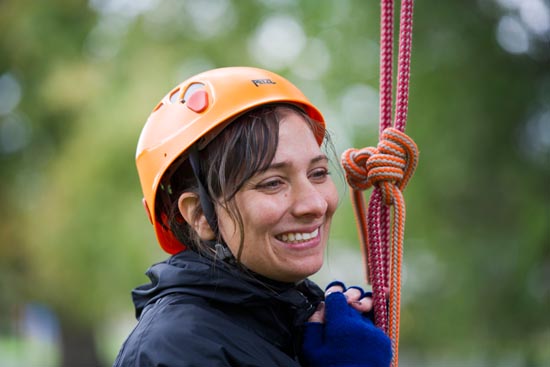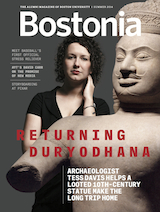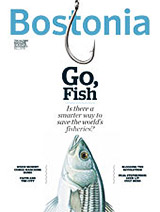Andrea DiGiorgio, a PhD candidate in biological anthropology, will spend the next year chasing orangutans through the jungles of Borneo, gathering samples of their food. DiGiorgio (GRS’18), who received a graduate research fellowship from the National Science Foundation, wants to learn more about primate evolution and conservation. But collecting orangutan food is not easy. DiGiorgio will need to catch falling fruit and climb 100-foot-tall trees, a skill she learned at the Cornell Tree Climbing Institute in Ithaca, N.Y. She spoke with Bostonia about the primates, their diet, and why she’s the one to call if there’s a zombie apocalypse.

DiGiorgio had to learn archery in order to get the rope into the tree. “If there’s any type of natural disaster, any zombie apocalypse,” she jokes, “I’m your go-to.” Photo by Cydney Scott
How did you end up studying orangutans?
Cheryl Knott, my advisor, studies orangutan behavior at the Cabang Panti Research Station in Gunung Palung National Park in Indonesia. And orangutans have a very interesting diet, so given that I wanted to study habitat use and diet, they are a great primate to research.
Why do habitat and diet interest you?
How an animal deals with its environment is such a major part of their evolution. Understanding how they get food, what size they can grow to based on the food that’s available and the space that they have, is just fascinating to me.
What do they eat?
Overall, orangutans are viewed as frugivores.
What’s a frugivore?
Animals that eat fruit. When fruit is available, orangutans will eat it. But they also eat leaves and bark.
Are they eating bugs in the bark?
There are termites and ants that they eat, too, but we don’t see them eating those as much. They eat this type of pith from within a tree—if you peel back the outer layer of the bark, it’s the inside. Why are they doing that? Why not stay with something that’s high sugar, high energy, like fruit?
Maybe they just need a little something crunchy.
Exactly. If you’re in a forest without potato chips, what do you do? [laugh] But overall, I think they’re probably trying to get x amount of protein during the day, which they may not be able to get from fruits.
Do you think they might get it from the bark?
So far, we don’t know. We need to analyze more bark, which is why I want to go over there and get hundreds to thousands of food samples.
How do you get thousands of food samples?
You sit and wait for the animal to wake up, and then you just follow them throughout the day. When they stop and eat, you write down everything that they’re eating, and you try to get a rate of how much is going into their mouth. And if they drop samples (which happens quite a bit), you can get samples that way, because they will be from the same part of the tree. The next day, I—or the two tree climbers—will go back and try to collect whatever food I couldn’t get.

Orangutans get most of their calories from fruit, sometimes up to 10,000 calories a day. Photo by Tim Laman
This is why you learned how to climb trees?
Yes.
Are the trees in Borneo going to be a lot more difficult to climb than the ones in Ithaca?
Yes. In Ithaca, they’ve picked trees for different reasons. The teacher knows which trees are safe to climb, because he’s investigated them. In the forest in Indonesia, you not only have a larger, taller, uninvestigated tree, but also lianas [vines] and other trees growing around them. And so just setting the rope is going to take between one hour and five hours.
Five hours to get a rope into the tree?
Yeah, to get a rope into the tree. I’m learning archery, because I need to be able to shoot arrows into the trees to get the rope in.
You’re building such an awesome résumé.
If there’s any type of natural disaster, any zombie apocalypse, I’m your go-to.
So what will all this information help us understand?
I want to work toward conservation. I’m interested in primates just for the sake of primates. We say orangutans eat certain fruits most often. But if we only conserve fruit trees, and they actually need other resources—like the bark—then even though we conserve what they eat most often, we may be inadvertently depriving them of something. I want to see if they need protein, I want to see if they need fats, so that we can start determining the types of trees and the types of habitats that are best to conserve. I feel very lucky to get to study orangutans, especially given that there aren’t that many of them left. Right now, there are probably fewer than 70,000 Bornean orangutans in the wild, and I hope to be part of their survival.
















































Related Stories
When Healthy Eating Becomes an Obsession
SAR nutritionist on the dangers of orthorexia
Beating the Binge
Alzheimer’s drug may reduce urge to eat compulsively
Why Do Monkeys Get Fat?
Biological anthropologist Christopher Schmitt on primates, genes, and obesity
Post Your Comment